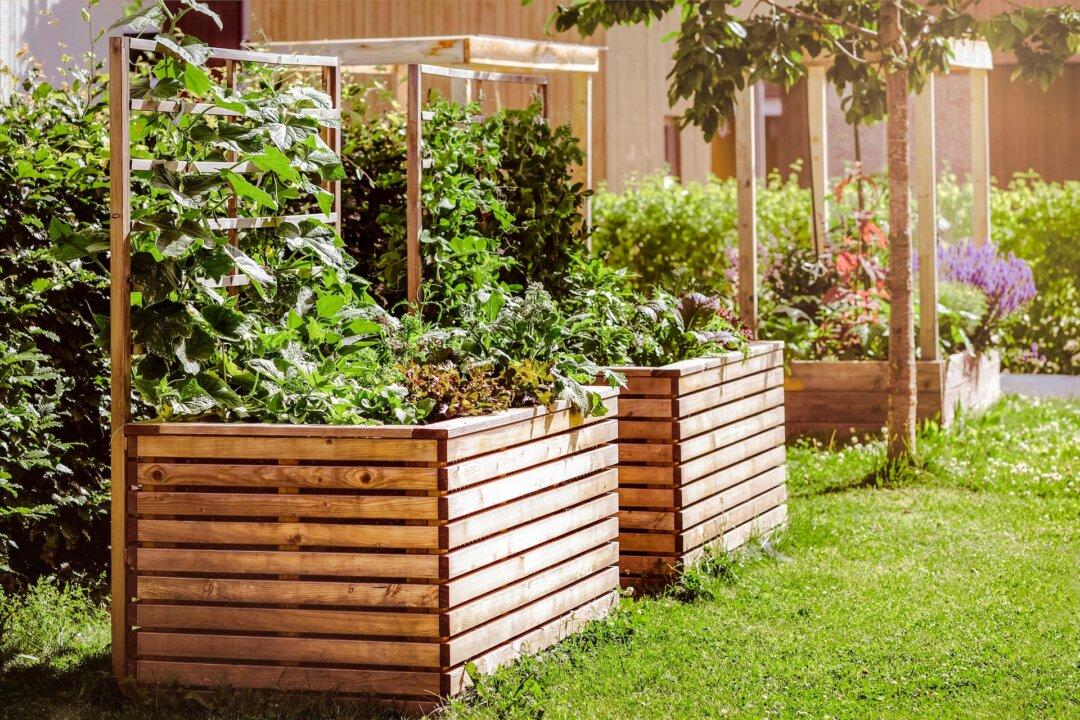Rainwater adds up, and quickly; one inch of rain runoff from a 1,000-sq.-ft. roof results in an impressive 600 gallons of water—just imagine how far that will go in the garden. Even a more typical spring or summer shower of a mere quarter inch can result in 150 gallons.
There may even be enough left over after watering the plants to wash the car.
Now, at this point, it must be noted that unless a complex and expensive filtration system is added, rainwater is considered non-potable water. But for gardeners, that’s perfectly alright.
A typical rain barrel system can be as simple as a 50- to 80-gallon barrel that sits at the bottom of a roof gutter downspout to collect water during a storm. Or perhaps two barrels for a typical gable roof home with a gutter running along each side. Larger barrels are available, including inground storage, which is particularly useful in areas with heavy rain followed by drought periods.
Want a quick start? Place a temporary five-gallon bucket at the bottom of the spout. Make sure it’s food grade with recycling code 1, 2, 4, or 5 on the bottom, particularly if watering crops.
No gutters? Parts are available at any home improvement store, and installation is an easy weekend DIY project.
Ecologically Advisable
Rainwater is often viewed as a nuisance or waste product by home builders and cities alike, with rooftops, streets, paved areas, and landscapes designed to drain rainwater (and snow melt) away as fast as possible into storm drains that connect via underground pipes to streams, rivers, or lakes.These storm drains can quickly become overburdened, particularly if they become clogged with leaves, sticks, and mud that can stress the system and lead to localized flooding. Rain caught in a barrel or other storage container means less rain running into storm sewers. Stormwater runoff also collects pesticides, fertilizers, animal feces, and other contaminants on the way to the streams, rivers, and lakes, so less runoff is better for the local ecosystem.
Getting Started
Rain barrels can range from repurposed 50- to 55-gallon drums up to 275-gallon totes that were previously used to carry food such as juices, olives, and pickles. Facebook Marketplace, Craigslist, and other online marketplaces may have cheap or even free offerings.There’s also a wide selection of more attractive 50- to 300-gallon specialized rain barrels made of plastic, metal, or wood available through home improvement stores and online vendors. There are even fancy models in glazed ceramics and plastics crafted to look like traditional wooden barrels or terra cotta for use in front of the home and other highly visible areas.
If you’re using repurposed food containers, wash them out with Dawn until there is no residue left, then fill them with a mixture of 3/4 cup of regular (not scented!) bleach for each gallon of water they can hold. Let them sit for 30 minutes, then drain carefully into an area that won’t be harmed, such as a bare (not colored or stained) concrete driveway, where it can do additional cleaning.
Most barrels will have a lid that either is pre-fitted or can be cut into with a jigsaw to fit a downspout or downspout extension. If not, a mesh drawstring cover will work to keep out leaves and other debris.
An uncovered rain barrel can become easily infested with mosquito larvae. You can use Bacillus thuringiensis israelensis (BTI) mosquito dunks (tablets) or apply a thin layer of vegetable oil on the surface, but these methods don’t keep out leaves.
Routing the Water
The next step is to get the water to the barrel from the home’s gutter system via downspouts and diverters that direct the flow into the barrel, particularly if it’s not situated directly next to the house. Large-diameter PVC pipe, rubber hosing, and tubing, if it’s at hand, can route the drain flow to the barrel.If you’re routing the water to a container with a mesh cover, stop the downspout or tubing just above the mesh and let gravity do its thing. Speaking of gravity, water runs can be as long as needed, but keep the water flowing in a downward pattern to avoid a backup.
If you’re using more than one barrel, consider simply buying a Rain Barrel Connector Kit. They’re normally priced below $20 and come with all the parts needed, including a 1 1/4-inch diameter or larger hose, connections, and the necessary drill bits.
Also, the average rain barrel set-up may not be able to contain the full roof runoff, particularly during a heavy thunderstorm. That’s OK. Simply install a Rain Barrel Overflow Kit to direct any excess water away from the home.








